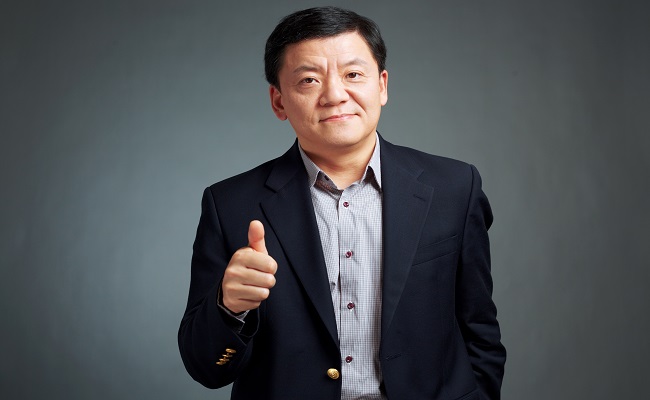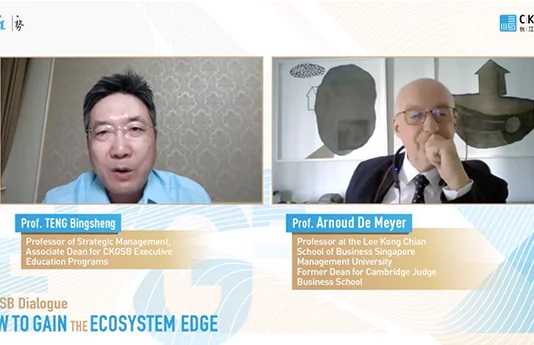Francis Hu, COO and CFO at 3M China, talks about the company’s ‘location management’ strategy and the opportunity in China’s push towards domestic consumption.
The 3M Company, the American multinational giant that gave the world Post-it Notes and the Scotch-Brite scouring pads (and also adhesive tapes for Frank Gehry’s iconic Walt Disney Concert Hall in Los Angeles), is considered one of the most innovative companies in the world. Unknown to many, 3M was also one of the first multinational companies to set up operations in China long before the country even had a foreign enterprise law. From humble beginnings in 1984, 3M China has grown to a $3 billion business, or 10% of 3M’s global business. The company’s China R&D center is already the largest one 3M has outside the US.
Clearly, the Chinese subsidiary is very important for the global parent. So much so that in September 2013, Greater China was carved out as a separate region. COO and CFO Francis Hu is practically a 3M China veteran. He joined the company in 1992 and watched closely as it grew to the size it is today. In this interview, Hu talks about 3M’s China strategy and how it is trying to realign it to match the Chinese government’s priorities for the economy. Excerpts:
Q. 3M entered China in 1984, long before the country was on any big MNCs radar. How easy was it to get in at that time and make a place for yourself?
A. (Setting up a company in China back then), from a legal infrastructure standpoint, was very difficult. In 1984, China did not even have a foreign enterprise law. It only had joint venture laws. You could not, theoretically speaking, be a company that was 100% owned by foreigners. From that perspective, the legal environment at that time was not even ready. But the Chinese government allowed us to establish (3M), almost in a similar fashion as of a joint venture, which is proof of the courage that they had at that time to attract foreign investment.
(Back then) I don’t think 3M had any strategy to grow to be worth $3 billion (in China). From a broader strategy base standpoint, we have been growing the company slightly differently than other manufacturing companies. Most of the companies use their China operation as a manufacturing hub. Rather (we have) set up a company purely for China. We set up manufacturing and R&D much later. Our strategy was indeed China for China, not China for global, or China for the region, or China for area.
The other thing is capability. You say, ‘I’m going to set up an operation for China.’ How are you going to develop that capability? (It) is not simply a local capability, even including the effort (of) pulling in other resources 3M has. Considering all these things, we have been developing very much on the self-reliance model. You can have external support—company support, regional support, area support—but after all, you have to be reliant on yourself. Talent is the first thing. 3M is probably one of the best companies in China today as far as localization is concerned. With only a couple of exceptions, virtually all in the management team are local. Localization doesn’t only mean people. In product development, obviously the technology base, in most cases of multinational companies, cannot be entirely local. You have to leverage your global resources and technology. But the aim is always local products. From a strategy standpoint, we want to be very local.
Q. What is the scale at which 3M China operates right now?
A. At this moment, the Greater China region accounts for around more than 10% of the company’s total global portfolio ($3 billion). We just formed a new area in September 2013. We used to be part of APEC. (Now) we will have China, Hong Kong, Taiwan and Mongolia as the Greater China region. These four locations will form a new area at the same hierarchy level as APEC.
Q. So, in effect, it shortens the line of control between you and the headquarters.
A. Yes.
Q. Why have they carved out Greater China as a separate region?
A. There are many reasons. Size matters. 3M was a $30 billion company last year. The China region will be more than $3 billion this year. 3M USA is about $9.5 billion. We are number two, if you consider the US as a subsidiary, and Japan is number three. When you elevate the area, China, is bigger than the size of west Europe in terms of profit. (Europe is divided into three parts: central, eastern, and western Europe.) Developing countries revenues (are now on) par with developed countries.
There are many (other) reasons too. Inner region obliviously, (they have) virtually the same Chinese culture and language. A lot of business, especially export business, is held at a regional level. Even though now our focus is becoming more about domestic consumption, export is still a very active sector of our business.
Q. What does this change for you?
A. The resources will be much more focused. Originally we had area resources covering the whole area. Now we will have dedicated area resources focused on China.
Q. A lot of MNC subsidiaries have a constant tussle with the headquarters regarding control over resources and decision-making. Does this also mean you also get a greater share of mind at the board level?
A. 3M is very unique. (3M’s) subsidiaries are basically local organizations. We have more business units than any other (multinational) companies. (3M China) has 33 or 35 big business units from a division standpoint. All are managed on a local basis. Everybody reports to the local MD. There are always pros and cons. (China) is not a mature market. You really have to leverage the resources, learn from each other and have a stronger location management.
We are basically a matrix organization because we still have a close alignment with the business back in the US, but we have a stronger influence on a local basis: not only 3M China but also other areas. You have to respect culture. If you really want to push hard for interference, you may hit a wall. The UK, Italy, Spain, France are probably different—they are very much like a US division extension. The Europe area business organization (is) directly connected with the US, because it is a very mature, developed market.
Q. What are the things that have worked our really well for 3M China and what are the things that didn’t?
A. When I joined the company in 1992, it was only a $20 million, or RMB 140 million, business. So in 21 years, from $20 million to almost $3 billion, is pretty good. But I don’t want to give ourselves too much credit because we are simply lucky. We followed (China’s) economic development. When I joined the company, two businesses accounted for about 85% of our business then: telecommunication (primarily connectors) and transportation (basically traffic signage, part of a business known as Traffic Controlled Materials (TCM)). Telecommunications accounted for about half of our business. There weren’t many roads at that time. The first highway in Shanghai was built in 1994 or 1995. So, of course, TCM is a booming business. At that time, TCM was not a very a big business for 3M globally and telecommunications was about $300 million. All of China was booming because we did not have other business.
China started becoming an export power in the late 1990s. So for 3M, industrial products started to kick in because you do everything virtually: mobile phones, TVs, electronics. Industrial is now our biggest business. Telecommunications and TCM are now very small. Moving onto this century, (we started on) automotive: manufacturing, after-market and car maintenance.
Lately when the government started talking about domestic consumption, the healthcare business has started. Who would have thought that 3M would do healthcare in the mid-1990s? It was too expensive to afford, even the import. Two, who’s going to grant a foreign company a healthcare supplier license? No way.
We’ve been lucky because at every stage of development, we have applicable products to sell. Obviously, we did a lot of localization.
Q. 3M China is recalibrating from exports-oriented businesses towards private consumption-led businesses in line with the country’s priorities. What does it really take to make that jump?
A. This is not a jump. This will be gradual. The competitiveness of the Chinese manufacturers is decreasing and demand has become weaker because the spending power in developed countries has become less. I don’t think the Chinese government is saying, ‘Let’s do less exports’. The industry itself is evolving from exports to domestic consumption. Take mobile phone companies, especially local ones. Originally, their portfolio may be 80% for export -import and 20% local. The portfolio of the local phones, or if you want to define them as domestic consumption, is more than 50% for sure.
The challenge for any multinational company, not only 3M, (is that they are) not very familiar with local business. Foreign companies used to export 60%. Now all of a sudden, they export 30%. It forces them to do something they do not know. They start to make products applicable to that segment.
Luckily, the industry we’re facing has not changed. It’s not like you do automotive today and people say all of a sudden, ‘Automotive has no future, you have to go to electronics’. (It’s just that) you used to do Audi and BMW, and now all of a sudden you do Great Wall. (Or) maybe they’re the same company, but the application is different. That’s a test for you on how quickly you can transform your technology, your manufacturing, your localization effort, into a different platform. Other people, even with less technical capability, in most cases Chinese companies, are moving up very quickly by the way. They are very familiar with that area.
Q. As an organization, how do you start prioritizing to make the change?
A. (Our strategy is) China for China. In other words, play as a local. The ‘how’ question is very difficult. Everybody knows what the end state is or what the ideal situation is. Take manufacturing. (Earlier) I could bring in a line from the US because they are pretty efficient and high-tech. Now you look outside and everybody can make the same machine at a third of the price. They operate with their salary being half of yours. You’re not going to say, ‘Because I can sell my brand. I can charge people double’. Those days are gone. So, they force you to prioritize.
I went to an OEM company. That single factory has 120,000 people manufacturing for several brands, not just for one. Think about the difficulty of managing 120,000 people in one site. Does 3M have that capability? No. That company’s model—they just make 2% margin maybe—is mass production. (There is) no risk because they have the confidence to manage 120,000 people. That’s their core competency, not 3M’s. Our competency is technology. If your product is two times more expensive than other people, why should people buy from you? We have to cut a long tail: you have so many staff, you cut them off simply because they will not pay off because we are expensive. Is this company expensive? Indeed. So we have to compete using our core competency. We will have to prioritize and work on our core competency. Of course, we need to improve manufacturing efficiency but that’s not an assumption you want to do this and you’ll be as good as Foxconn.
Q. What about the weightage between different businesses in your portfolio? Are you changing that? I am assuming healthcare will now be a big business for you.
A. Of course. We moved people, especially this year. The energy business has been shrinking because the external environment has changed. So we have reassigned many people from that business into a faster-growing business. An example of a fast-growing business is water—purification. We grew it from RMB 6 million to RMB 25 million in two years. That’s the beauty of location management. You have a lot more flexibility. Automotive is flying for us. The safety, or personal care business—e.g., respirators—are good businesses.
Q. Who do you consider competition, given the fact that you have really diverse businesses? Do you think Chinese companies are starting to pose a serious threat?
A. Definitely! Originally, we had strong competition from multinationals because we are a technology-driven company. Then, obviously, we try to move down the (income pyramid). We have to expand our tier strategy from A to B to even C, in some cases. Originally, we were concerned about other multinationals doing similar things like localization. From a localization-drive standpoint, I think 3M is better than many of the foreign companies. On the other hand, the improvement of the local companies was surprising to us. So you think about having two groups: the foreign company trying to be local; the local company is trying to be high-tech or move up in the portfolio. I think the (local) group is doing better than the (foreign) group.
Q. How do you plan to compete with them?
A. We want to be local. We want to put more resources into technology and R&D. (We) have to start to think of the alignment with many local companies: customers and suppliers; trying to become part of them. From a strategy standpoint, you want to consider competitors and customers a little more seriously. Your suppliers used to be foreign, now they are local suppliers. You’re actively looking for local suppliers and customers. You only used to look for high-end stuff, (like) BMW. Now all of a sudden, they think maybe Great Wall (Great Wall Motors, a Chinese auto company) has a better opportunity. You try multiple things because you have different touch-points.
Q. What about the future? What do you see yourself doing more of in China? I believe there is also a push to go from the east towards the north.
A. Yes and no. From a manufacturing standpoint, if we’re going to move over to the west the reason is not cost because 3M is not a low-cost manufacturer. If we’re going to move inland, we will because we want to be close to our customers. The government is promoting investment, promoting (the) industrialization of those regions so we follow our customers. We just set up a north region organization in Beijing. It’s a regional headquarter for the execution rather than management. It covers 8-9 branch offices in the north like Dalian, Shenyang, Jilin and Tianjin. The business used to be managed by business. In other words, if you’re industrial, you’d report back to industrial Shanghai. Now they report to the regional office. When we become bigger in China, we want to adopt a regional approach. We’re going to set up a south (regional office) in the future, mid-west too.

















